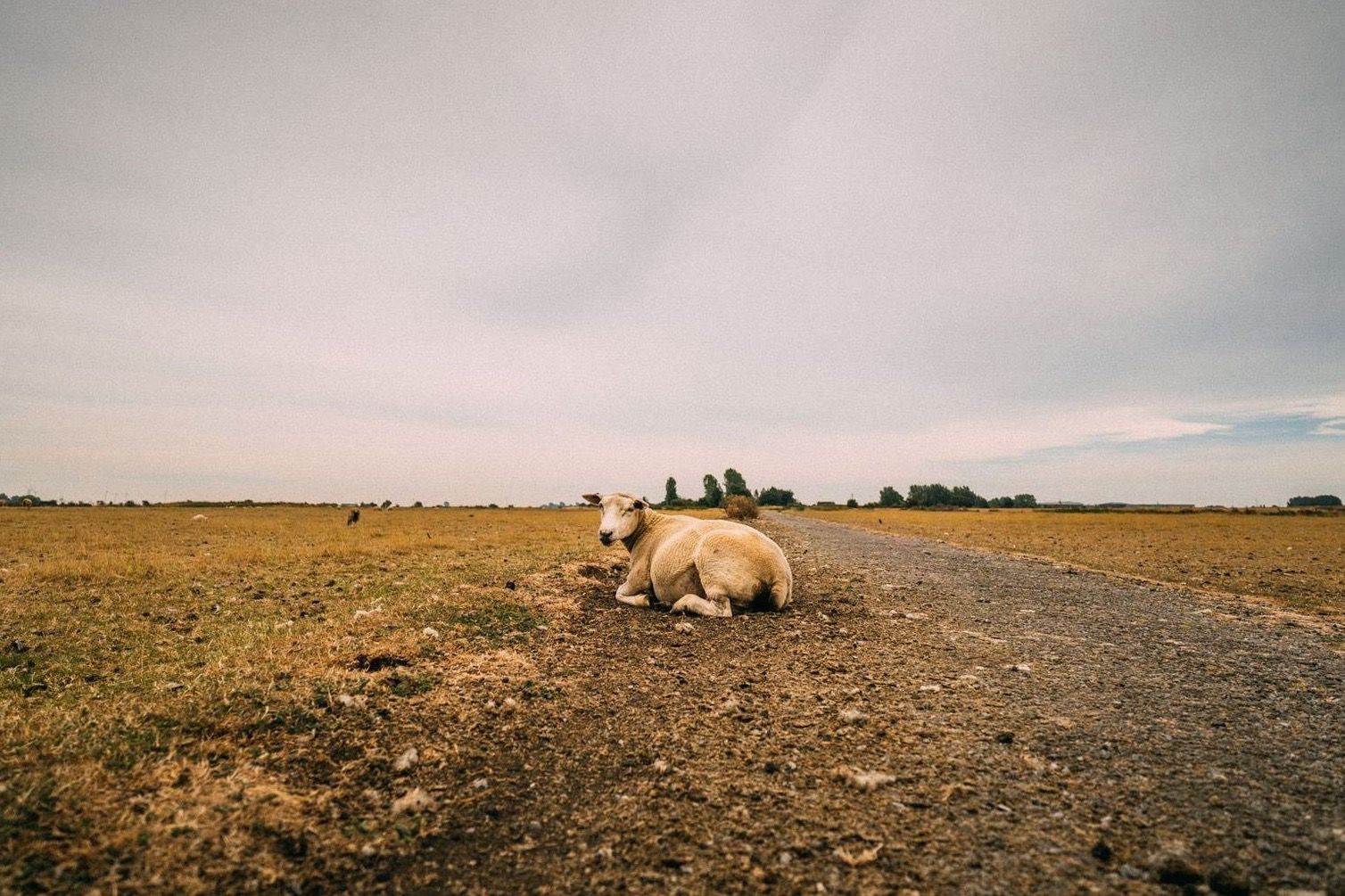Why is Wool so Baaad? An Introduction to the Lives of Sheep in Slavery

"Just keep riding and don't look to the left," Steven said with a sense of urgency.
We were on a public trail crossing through a farmer's field and the narrow path took us straight through a cluster of barns, a common occurrence in the UK.
On this particular day we were just outside of Perth after camping in a public forest atop a ridge. We'd cycled up this same farm field the previous day and noticed all the sheep mingling about.
Now they were rounded up in one of the barns, packed tightly and looking silently our way.
Or maybe they were looking toward their slaughtered companions.
Steven explained the scene as we cycled away.
"There was a farm worker standing in a concrete paddock and at this feet lay two sheep with their throats slit."
This was the sight he was trying to shelter me from. I scoffed, unable to believe that such a thing would be happening, especially in broad daylight and within sight of the other sheep.

I protested in vain. I knew this was happening to millions of sheep all over the world. In 2016, an estimated 550 million sheep were slaughtered for food and that number is only steadily rising as appetites for cheap meat and economic demands increase.
Contrary to popular belief, most sheep are killed for their flesh when they no longer produce profitable wool because there's a market for eating them. This is only one reason of many why the wool industry is in fact a killing-machine, rather than the benevolent trade it strives to paint itself as.
Packages of wool often picture images of sweet lambs in flower fields or flocks of sheep lit up by glorious sunshine and idyllic landscapes. This is far from the mainstream and far from the truth.
Wool packaging is propaganda.
We invite you to view Surge Activism's extensive investigations into the wool industry for a comprehensive look into what's really happening:

The reality of the wool industry is brought to light in this short film by activist Joey Carbstrong:
Animal Liberation outlines 16 reasons to stop wearing wool:

Watch this film by Collective Fashion Justice, a movement to make the fashion industry just and ethical for all animals, humans and the entire world.
The film provides a harrowing look into the sheep abuse industry whilst showing the beauty of two lambs, Willow & Claude, and sharing ethical alternatives to wool. From the description:
"Willow and Claude is a short film which follows Collective Fashion Justice's founding director, Emma Hakansson, along her search for a total ethics knitwear supply chain. Learn about the issues tied up with the wool industry, the need for natural fibres, and some of the problems in some cotton production, before following Emma as she meets an Australian cotton farmer, and produces ethical, more sustainable knitwear."
Learn more about how you can support the incredible work of Collective Fashion Justice and their initiatives through Willow & Claude.
The Collective Fashion Justice has a range of illuminating articles on the wool industry and a good place to start is here:

Vast environmental impacts of the wool industry:
What we witnessed while cycling across the UK and western Europe:
We have greeted thousands of sheep, for more than the number of miles we've cycled so far. When we left Essex in early April we began to notice a pattern. The fields were full of lambs, many newborn and small youngsters running to their mothers and wagging their tales with great vigor every time they fed. Gradually, the lambs got bigger and bigger as we headed north.
It became clear that farmers follow the same recipe for sheep raising all across the country. These gentle animals "baaa"ed as we passed by, ran when suddenly alarmed by our presence or simply stood and watched with curiosity. We noticed how some of the sheep let out a distinctive "warning" call when we approached, noting how they have their own complex communication style.

We encountered many, many other animals trapped in the agricultural industry but the sheep became a leading spirit guide for this portion of our journey. Hence the opening illustration of this website.
Some of the encounters with sheep were bittersweet and heart-breaking.
In late July we neared Folkestone and stopped at a small family-run outdoor cafe called Freda's Coffee Shop. We were drawn in by the word "vegan" on their sign, but it turns out they didn't have any vegan food options that day. The dad and daughter team working there, Matt & Annabelle, are lovely and super kind. Normally they do have vegan goods but were out. They were happy for us to eat our breakfast while we enjoyed some of their vegan-friendly beverages, which were a delicious treat. Steven engaged with them in lively discussion on all things vegan and they connected with everything he was sharing, themselves already on board with the topics.
We left there with a remarkable promise.
They gave us a pledge. "When you're done cycling around the world and come back here one day, we'll be fully vegan."
A sheep continued to enter in the fenced in seating area while we ate, lured by the green foliage from small decorative trees dotted about the tables. Matt ushered this sheep out a couple of times, and she kept trying to reenter. She understood how to open the gate with their head. We named her Freda, in honour of the cafe.

We thought the situation was fun until we saw what was really happening.
As we cycled away from the cafe we rode into a farmer's field. The field was a large, dry pastureland dotted with just a few swaying sheep. We were immediately struck by the barren land and depressing scene. Most of the sheep were flanked up against a fence, laying in the only hint of shade, which was virtually non-existant. It wasn't even sunny at that particular moment but they looked wiped out.
The sheep were hot, thirsty and lethargic. Record summertime temperatures had them searching for shade in every possible corner. The scene we cycled through obliterated every image of the happy sheep jumping through blissful green fields. What we saw was suffering.
We couldn't see any sign of water or even food. The edge of the field paralleled a narrow streambed, but it was dry.


These animals are enslaved.
While there is much more we can share about the wool industry and lives of sheep, we ask you to view the information above and end for now with an invitation.
Imagine your childhood self. You're in a field and a playful lamb approaches you, tail waving and legs jumping in a delightful dance. What is your inclination at this moment?
If you feel pulled to engage with the lamb, pet her or play, or simply just observe with curiosity, then this is the feeling to guide you. May we grow our empathy for animals together, honor them for the magnificent beings they are, and stop using them for the unnecessary production of wool and flesh.
Today there are many alternatives to wool that are far better for the animals and the planet, so take the step by learning more here:

Written by Karla Sanders @karlasandersart | Photos by Steven Tiller @steventiller




